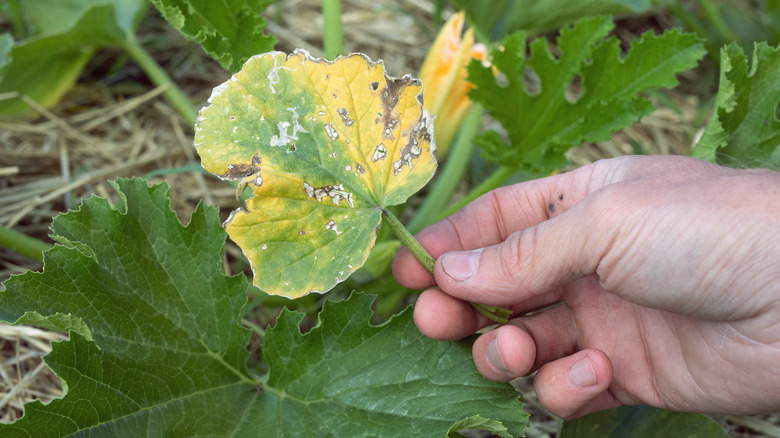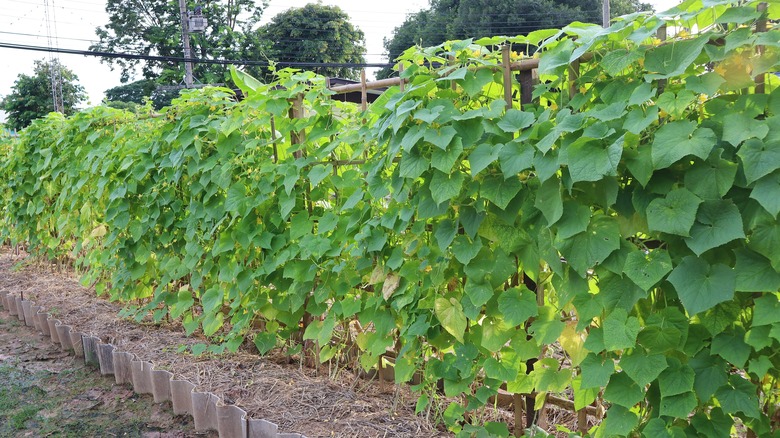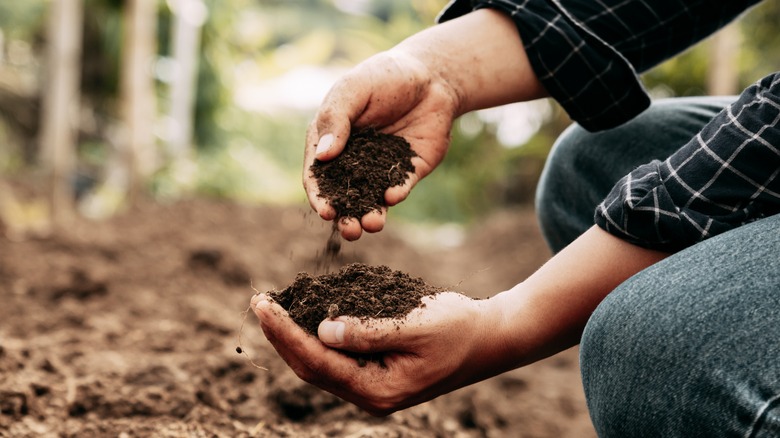Why The Leaves On Your Zucchini Plant Are Yellow, Not Green
The sight of yellow leaves tends to ruin a gardener's day, especially when the leaves are attached to a crop they've so diligently tended. When a zucchini plant is at its healthiest, the leaves are soft, wide, and deeply green. A yellow leaf, meanwhile, indicates trouble is brewing either above or below the soil. Pinpointing the cause of the color change is your first step in correcting the issue.
Discoloration in plants can be caused by a number of environmental factors, some of which cannot be avoided. However, discoloration may also be attributed to gardening errors. Perhaps the easiest cause to identify is actually a combination of the two. Much like its cousins, the yellow squash and cucumber, zucchini loves, and really needs, to be planted and grown in the warm summer months. Many gardeners will tell you the soil and air must be above 60 degrees Fahrenheit, but Oregon State University says the plant much prefers its growing temperature to stay between 70 and 95 degrees. If you happen to plant too early or your garden experiences a rogue cold front, the plant will more than likely respond with yellow leaves. If, however, you know for a fact the zucchini seeds have grown in optimal conditions, it's time to consider other potential suspects.
Other culprits of yellow zucchini leaves
Water is essential to plant growth, but it can also be a plant's downfall when given or taken away too freely. Yellow, droopy leaves are usually a clear indication that a zucchini plant is getting too much water, while dry yellow leaves are a sign of too little hydration. You can check for both by dipping your fingers down into the soil. If you feel moisture a few centimeters below the surface, it's plenty hydrated. A dry undersoil means the soil needs a bath in the water hose.
Pests are another thing to consider when hunting for a yellow leaf culprit. Many insects take a particular liking to zucchini, including spider mites, squash bugs, and aphids (via Northeast Wildlife). You'll want to identify the insect before proceeding with treatment. If you decide to use a pesticide, read the bottle carefully to avoid further damaging the plant. The same can be said for fertilizers. You always want to be sure you're not mishandling the product since doing so can cause a plant to deteriorate.
One of the last things on the culprit checklist is disease, though signs of such a case are usually apparent. Most plant diseases will present themselves as odd patterns and discolorations on the leaves or stems, or the effects of the disease will be reflected on the fruit itself. Again, you'll want to identify the disease before determining if treatment is possible.
Best practices to prevent yellowed leaves
Setting up your zucchini plants for the best chance of success begins at the seedling stage. These plants can survive a brief period of cold but not prolonged stretches, so it's best to plant a little later into spring or even the beginning of summer if a peculiar cold front is forecasted. On TikTok, HGTV explains that just four hours in the cold can do irreversible damage to a zucchini plant. When planting straight into the ground, pick a spot that's going to allow for full sun, as too little sunlight is another common cause for yellow leaves.
Your soil needs to allow for good drainage, and it needs to be filled with the right nutrients, too. Test your soil's pH before planting and adjust as necessary; Oregon State University says a pH level between 6 and 7.5 is ideal. If you're particularly worried about your soil, consider a raised bed over direct sowing. This will allow for more control. You can also help ward off pests by situating companion plants near the zucchinis.


